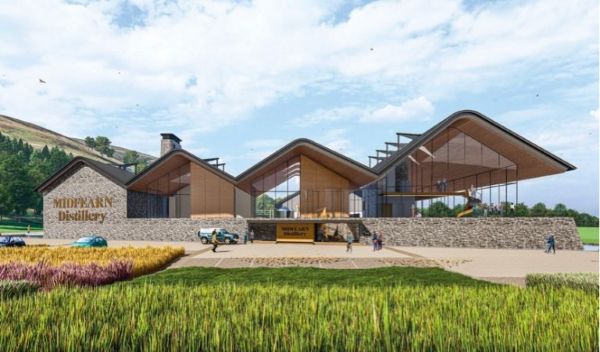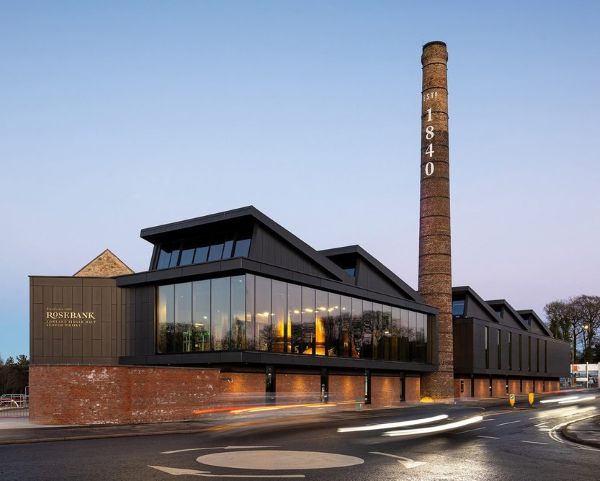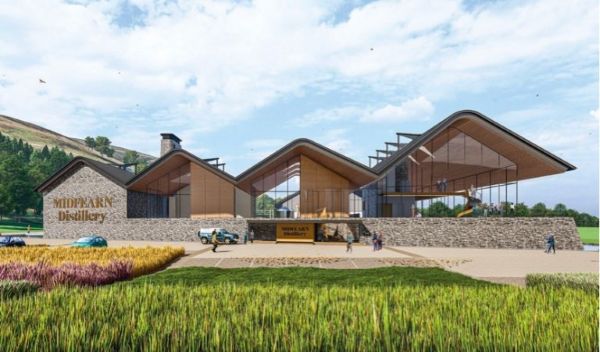Designer Distilleries
In days gone by, those designing whisky distilleries simply had to satisfy the needs of the production process. For today's architects, visitor appeal and aesthetics are just as important, discovers Ian Fraser …
The surge in new Scotch whisky distilleries – 32 have opened since 2015, with 14 opening the previous decade – has recast the whisky industry in many ways, some of which have yet to be fully recognised. But one of the most obvious is how it has transformed distillery design.
Today, architects, engineers and others involved in construction have more freedom to experiment with materials, building techniques and designs than their Victorian forebears. They're also more focused on aspects of industrial design, such as the most logical production sequence through a building, how to iron out inefficiencies and how to minimise wasted energy.
"The advantage of building from new is you're able to start with a simple form and layout. Grain is always the biggest bit, then you can fan out to the stills at the front. It enables you to have a more logical production flow," explains Jeremy Scott, chairman and head of design at Michael Laird Architects. "A distillery is not an office or a museum. It's an industrial process, a finely-tuned factory. There are process pipes and equipment to consider right from the start. To organise it, you fundamentally have to understand the process."
But today's distillery architects are also focused on something else - ensuring new distilleries will be as enticing to visitors as possible. In many cases, you could say distillery design has become an extension of marketing, something that will give a single malt brand a USP in a crowded marketplace.

"There's two sides to every successful distillery project," says Gareth Roberts, founder of Organic Architects, which designed the Ardnamurchan, Nc'nean and Lindores Abbey distilleries. "First, you have to accommodate an industrial process, which has to be very efficient, integrating modern-day, energy-saving technology.
"Secondly, you have to produce a beautiful building. The only beautiful buildings left in the world [in terms of new-builds] are branded buildings. Schools aren't beautiful anymore; hospitals aren't beautiful anymore. But branded buildings have to be beautiful, because they represent the brand."
Among the distilleries that Organic has designed, Roberts singles out Lindores Abbey, completed in 2017 for clients Drew and Helen McKenzie-Smith near Newburgh in Fife, as the best example where the character of the building reflects the character of the brand. "You've got that visual link between whisky production in the 21st century and the ruins of the abbey, from the 14th and 15th century." Roberts, also behind eco-distilling consultancy Pagoda Management, adds: "Whenever Organic Architects start to work on a new distillery, we work on the brand and the story that the place wants to tell, and design around that story."
A few 'craft' distilleries have simply restored or extended traditional Scottish farm-steadings. This is the case with Kingsbarns in Fife, Torabhaig on Skye, Nc'Nean on the Morvern peninsula, Ballindalloch on Speyside and Dunphail in Morayshire. Several of these projects have been overseen by restoration architects Simpson & Brown.

The circa £18m Rosebank distillery project also involved the reuse of an existing building, but was on a different scale. The defunct distillery by the Forth and Clyde Canal in Falkirk, which had been closed by former owners UDV (now Diageo) in 1993, was facing almost certain demolition.
Scott says the creation of an attractive and appropriate building mattered to clients Ian Macleod Distillers, the Broxburn-based firm which acquired the site, so they could attract visitors and complement iconic nearby structures such as the Falkirk Wheel and Kelpies. Personally, he rejects the word "iconic" for Rosebank, saying MLA prefers to focus on creating "appropriate modern buildings, without reverting back to history or pastiche. History is a good reference point, but you shouldn't copy, you need to keep moving forwards."
Reflecting on the Rosebank project – which has scooped architectural awards, including from the Royal Incorporation of Architects in Scotland (RIAS) and the Architectural Journal – Scott says: "From day one, our idea was that it's a shop window displaying the still and operation to the public. It's the yin and yang, the new and the old, and the belief in the future and in modern architecture. What Ian Macleod Distillers do very well is custodianship and belief in design quality for the next generation."
MLA has also worked on the Port Ellen, Clynelish and Glenkinchie for Diageo which has either involved resurrecting mothballed distilleries or interweaving enhanced visitor attractions into existing sites. Diageo recently lodged a planning application for a new distillery at Talisker, which MLA is involved in, and the design team are hoping to gain consent from Highland Council as soon as possible.

Malcolm Fraser, founder of Fraser/Livingston Architects warns against trying too hard to create a "wow" factor. "Much of the beauty in the world comes from utilitarianism," he says. "And much of what's wrong with architecture at the moment is that we make quite shoddy utilitarian buildings, and then fuss about them trying to make them look beautiful, by sticking wafer-thin stone onto the outside or silly additions such as Charles Doig-style pagodas."
"I think we ought to be making distilleries simpler and more functional and utilitarian, while ensuring they're properly and solidly built," he adds. "Many recent distilleries are a portal frame, some wrinkly tin, with a bit of stone on the front to make it look old. We should be doing more with timber, of which we have an abundance in Scotland."
This is something Fraser/Livingston intend to do at the planned Heaval distillery on Barra, which Fraser says will be small, exclusive and community-benefit-owned. "We're going to try and do something with a laminated portal frame, and timber infill. We'll be trying to make it a simple contemporary, vernacular piece of utilitarianism."
Despite his criticisms, Fraser sees many positives in Scotland's new cohort of distilleries. "There are good things happening in terms of the reuse of historic buildings and the opening up of these buildings to make the process more visible and enable visitors to catch the view. These are good trends, and it's good to see them being embraced."
Distilleries – in the words of architects
Port of Leith - Edinburgh
Architects: Threesixty; cost £12m; opened September 2023
Gareth Roberts: "The idea of it and the fact you're building a tower in that location next to the Britannia is brilliant if you've got the mental strength to see that through – really good for them."
The Macallan - Speyside
Architects: Rogers Stirk Harbour + Partners; cost: £140m; opened June 2018
Jeremy Scott: "Macallan is an amazing example of a modern functional distillery. You've got such high levels of whisky production and the difficult topography of a rolling hillside, which they mimicked with the undulating roof. I think it has settled down really well."
Holyrood - Edinburgh
Architects: 7N; cost: £5.8m; opened: July 2019
Malcolm Fraser says "The Holyrood distillery is in an old engine shed, and that's a lovely use for an old building."
Dalmunach - Speyside
Architects: Norr; cost: £25m; opened: June 2015
"That is a really good contextual way of placing a huge distillery, with the Y-shaped form and the visible gables," says Scott. "While it makes a nod to traditional design it is no pastiche. It works really well."

Ian Fraser is a financial journalist, a former business editor of Sunday Times Scotland, and author of Shredded: Inside RBS The Bank That Broke Britain.
